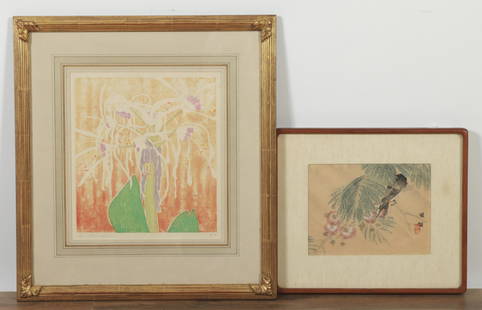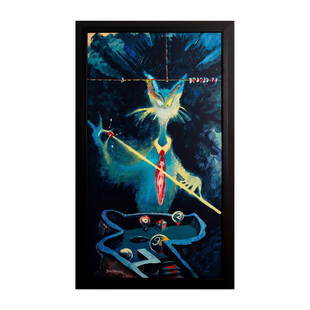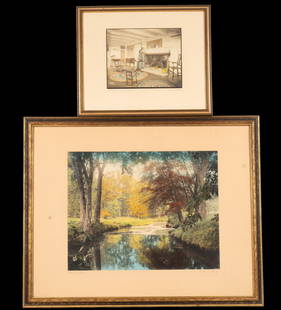
Roman Mosaic w/ Cupid, Water Nymph, Lion, & Bird
Similar Sale History
View More Items in Prints & MultiplesRelated Prints & Multiples
More Items in Prints & Multiples
View MoreRecommended Art
View More




Item Details
Description
Roman, Imperial Period, ca. 1st to 3rd century CE. An exceptional section of a frieze or border from a Roman mosaic wall or floor decoration presenting an action-packed scene in which a lounging water nymph watches a lion pursuing a winged Cupid (Greek Eros) through a verdant landscape of acanthus leaves that encircle each figure. Holding a lyre, the winged deity flees to the left toward a long-necked bird, while glancing back at the ferocious lion. The roaring beast is shown in profile as he strides toward his prey. To the right, a nude nymph gazes at the ongoing chase, propping up her voluptuous body from a stream or river using her left elbow. Her sweet face displays soft features framed by flowing blonde hair as she motions toward the main action with her right arm. All is delineated in square, rectangular, and triangular glass and stone tesserae in vibrant hues of blue, yellow, green, red, peach, beige, orange, tan, brown, white, and black. Size (of mosaic): 32.5" L x 11.75" H (82.6 cm x 29.8 cm); Size (of frame): 35.25" L x 14.375" H (89.5 cm x 36.5 cm)
In the classical world, lions symbolized power, wealth, and might. They were famously featured in many ancient myths, perhaps the most famous being that of Hercules (Greek Herakles) slaying the Nemean lion for his first labor. The lion's fur was believed to be impenetrable to attacks since according to legend it was made of gold and its claws were far sharper than swords with the power to slice through armor. In the end, Hercules defeated the lion by strangling it and wore its skin. Lions were also favorite iconography for buildings, coins, and statues. Examples include the Lion Gate to the Citadel of Mycenae, the Terrace of the Lions on the island of Delos, and the lion hunt mosaic from Pella featuring Alexander engaged in a lion hunt. Of course, lions were also used in the Roman arenas where they would fight other animals, such as tigers and bears.
Mosaics (opus tesellatum) are some of our enduring images from the Roman world, not only for their aesthetic beauty, but also because they reveal what Romans chose to depict and see every day decorating their private and public spaces. Mythological hunting scenes, like this example, commonly adorned the homes of the elite, serving as both playful and sumptuous decor. In the Roman province of Syria, which encompassed most of the ancient Near East/Levant, mosaics seem to have developed as a popular art form relatively late, with most finds coming from the 3rd century CE or later. Syria was one of Rome's wealthiest provinces, but it was also far removed from Rome itself and Roman culture was overlaid on enduring cultural traditions from Hellenistic Greece and the great civilizations that came before it. For example, Antioch-on-the-Orontes (modern day Antakya, Turkey), was the capital of northern Roman Syria, and its excavations in the 1930s revealed more than three hundred mosaic pavements.
This piece has been searched against the Art Loss Register database and has been cleared. The Art Loss Register maintains the world’s largest database of stolen art, collectibles, and antiques.
Provenance: ex-Phoenicia Holyland Antiquities, New York, New York, USA, acquired before 2010
All items legal to buy/sell under U.S. Statute covering cultural patrimony Code 2600, CHAPTER 14, and are guaranteed to be as described or your money back.
A Certificate of Authenticity will accompany all winning bids.
PLEASE NOTE: Due to recent increases of shipments being seized by Australian & German customs (even for items with pre-UNESCO provenance), we will no longer ship most antiquities and ancient Chinese art to Australia & Germany. For categories of items that are acceptable to ship to Australia or Germany, please contact us directly or work with your local customs brokerage firm.
Display stands not described as included/custom in the item description are for photography purposes only and will not be included with the item upon shipping.
#166420
In the classical world, lions symbolized power, wealth, and might. They were famously featured in many ancient myths, perhaps the most famous being that of Hercules (Greek Herakles) slaying the Nemean lion for his first labor. The lion's fur was believed to be impenetrable to attacks since according to legend it was made of gold and its claws were far sharper than swords with the power to slice through armor. In the end, Hercules defeated the lion by strangling it and wore its skin. Lions were also favorite iconography for buildings, coins, and statues. Examples include the Lion Gate to the Citadel of Mycenae, the Terrace of the Lions on the island of Delos, and the lion hunt mosaic from Pella featuring Alexander engaged in a lion hunt. Of course, lions were also used in the Roman arenas where they would fight other animals, such as tigers and bears.
Mosaics (opus tesellatum) are some of our enduring images from the Roman world, not only for their aesthetic beauty, but also because they reveal what Romans chose to depict and see every day decorating their private and public spaces. Mythological hunting scenes, like this example, commonly adorned the homes of the elite, serving as both playful and sumptuous decor. In the Roman province of Syria, which encompassed most of the ancient Near East/Levant, mosaics seem to have developed as a popular art form relatively late, with most finds coming from the 3rd century CE or later. Syria was one of Rome's wealthiest provinces, but it was also far removed from Rome itself and Roman culture was overlaid on enduring cultural traditions from Hellenistic Greece and the great civilizations that came before it. For example, Antioch-on-the-Orontes (modern day Antakya, Turkey), was the capital of northern Roman Syria, and its excavations in the 1930s revealed more than three hundred mosaic pavements.
This piece has been searched against the Art Loss Register database and has been cleared. The Art Loss Register maintains the world’s largest database of stolen art, collectibles, and antiques.
Provenance: ex-Phoenicia Holyland Antiquities, New York, New York, USA, acquired before 2010
All items legal to buy/sell under U.S. Statute covering cultural patrimony Code 2600, CHAPTER 14, and are guaranteed to be as described or your money back.
A Certificate of Authenticity will accompany all winning bids.
PLEASE NOTE: Due to recent increases of shipments being seized by Australian & German customs (even for items with pre-UNESCO provenance), we will no longer ship most antiquities and ancient Chinese art to Australia & Germany. For categories of items that are acceptable to ship to Australia or Germany, please contact us directly or work with your local customs brokerage firm.
Display stands not described as included/custom in the item description are for photography purposes only and will not be included with the item upon shipping.
#166420
Condition
Mounted on a concrete backing and framed. Small losses to some tesserae, with chips to some tesserae. Otherwise, in great condition with beautiful preservation to zoomorphic imagery as well as tesserae coloration.
Buyer's Premium
- 24.5%
Roman Mosaic w/ Cupid, Water Nymph, Lion, & Bird
Estimate $10,000 - $15,000
39 bidders are watching this item.
Shipping & Pickup Options
Item located in Louisville, CO, usOffers In-House Shipping
Local Pickup Available
Payment

TOP










































![French Sepia-Style Print of a Lion: Mid-20th century reproduction French sepia-style print, "Lion d'Afrique". [Art: 10" H x 13" W; Frame: 24" H x 27" W].](https://p1.liveauctioneers.com/1221/329897/178115687_1_x.jpg?height=310&quality=70&version=1716387921)


























![Emilio Grau-Sala "Sur la Plage" Oil on Canvas: Emilio Grau-Sala (Spanish, 1911-1975), "Sur la Plage" [On The Beach], Oil on Canvas, 1958, signed "Grau Sala" lower right, signed, inscribed "Trouville", dated, and titled to verso. Image: 21.5" H x 2](https://p1.liveauctioneers.com/5649/328023/176731071_1_x.jpg?height=310&quality=70&version=1714409606)











